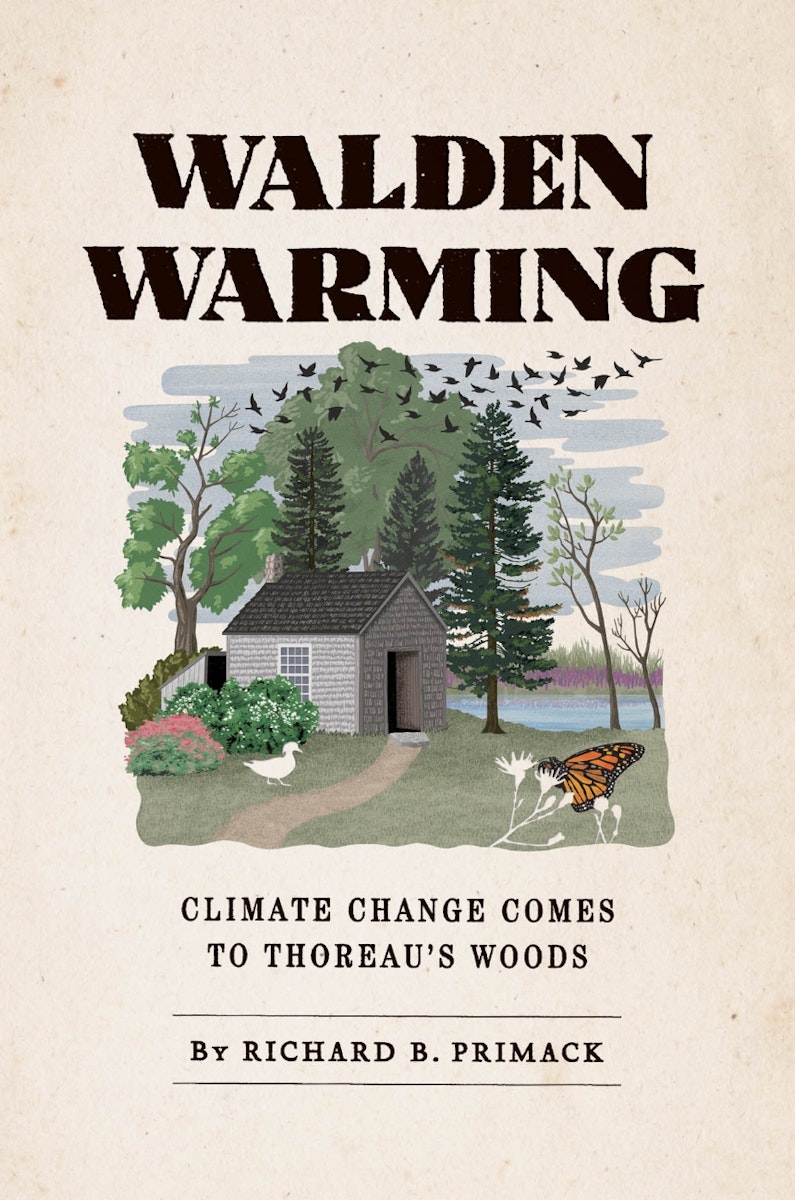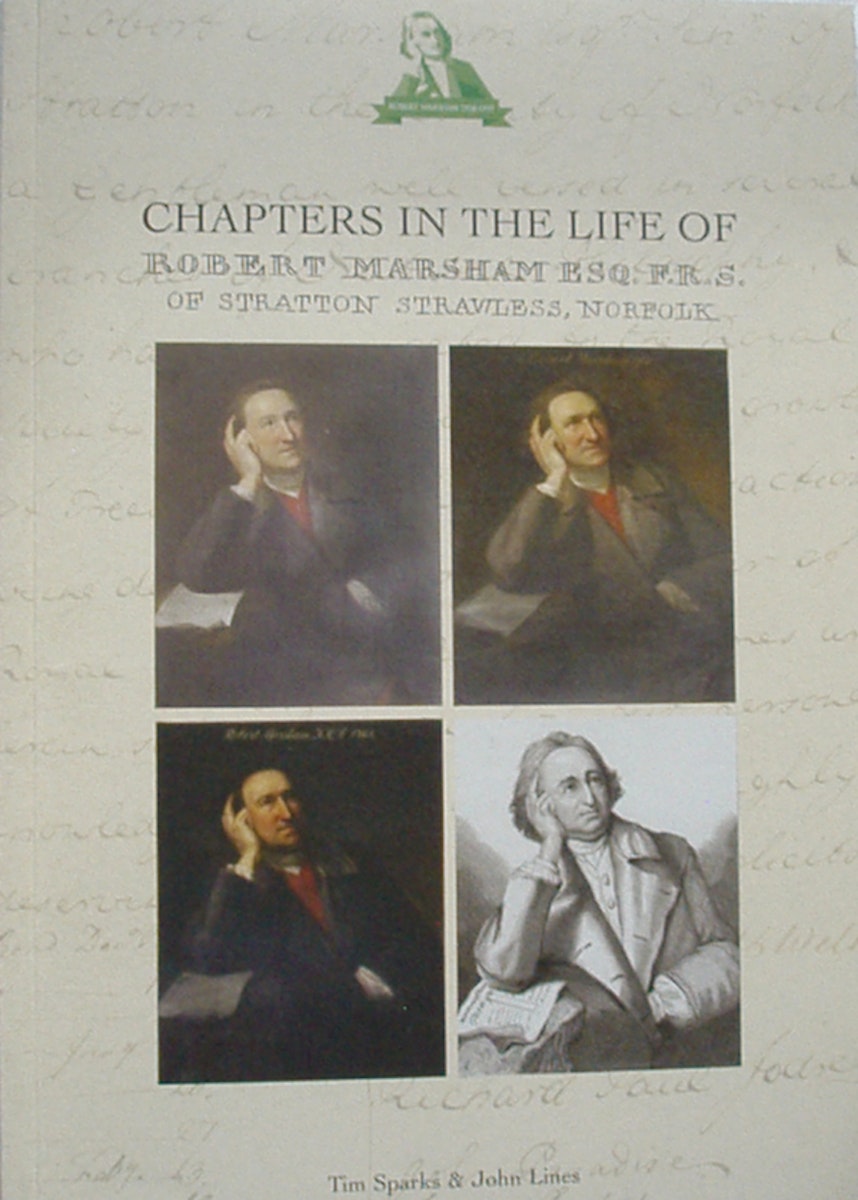
From Snowdrop to Nightjar Robert Marsham’s “Indications of Spring” (1789)
What can we learn from observing the progression of spring — a hawthorn’s first flowering, the return of birdsong on a particular day? Hugh Aldersey-Williams explores the lifelong calendrical project of Robert Marsham, the Norfolk naturalist considered Britain's first phenologist.
March 7, 2024
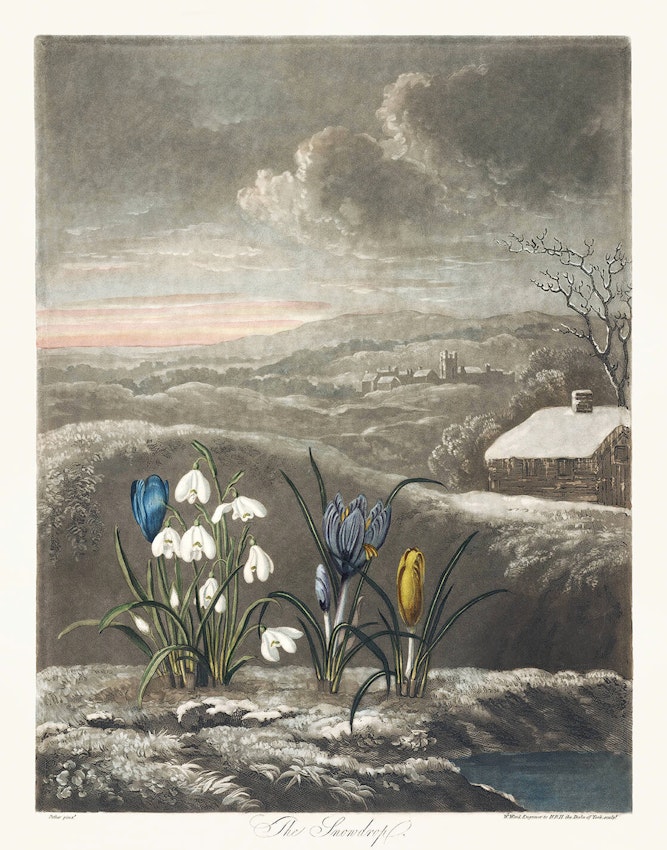 Scroll through the whole page to download all images before printing.
Scroll through the whole page to download all images before printing.“The Snowdrop”, a plate from “The Temple of Flora”, the third and final part of Robert John Thornton’s New Illustration of the Sexual System of Carolus von Linnaeus (1807) — Source.
21 January 2024: Today I notice the first snowdrops rising from leaf litter in the woods where I live a few miles from Stratton Strawless.
Spring came late to much of the northern hemisphere in 1784. One reason we know this is because of records made by Robert Marsham of Stratton Strawless in Norfolk, England, in which he noted that his hawthorns began to leaf on April 22, fully two months later than in recent previous seasons, and the latest by far in all the forty-eight years he had been keeping records. The anomaly was due to an eruption of the Lakagígar volcanic fissure in Iceland that past June, which had led to a hot, cloudy summer followed by an extremely hard winter in much of Europe.
In 1736, while still in his twenties, Marsham embarked on his lifetime project of recording what he was to call his “Indications of Spring”. He noted down the dates of biological events related to the indigenous flora and fauna, and made more general observations too. During the exceptionally cold winter of 1739–40, for example, he wrote that many of his trees split apart and the urine froze in his chamber pot. In Norwich and surrounding areas, there were food riots “for which some were hang’d at ye next Assizes”.1 As a prominent landowner, Marsham served for much of his long life on local assizes juries, and, fearful of revolutions like those in America and France, played his part in handing down these harsh sentences.
Although most of his journals and letters have been lost over time, “Indications of Spring” has survived because, after a half-century of assiduous data entry, he presented his accumulated findings to the Royal Society. To Joseph Banks, the society’s president, Marsham wrote: “As I know of your boundless curiosity, I think it possible that an imperfect Calendar of some few articles of Spring, many years past, may afford you some amusement.”2 The calendar was published in the society’s journal, Philosophical Transactions, the following year as a tabulation on three foldout pages.
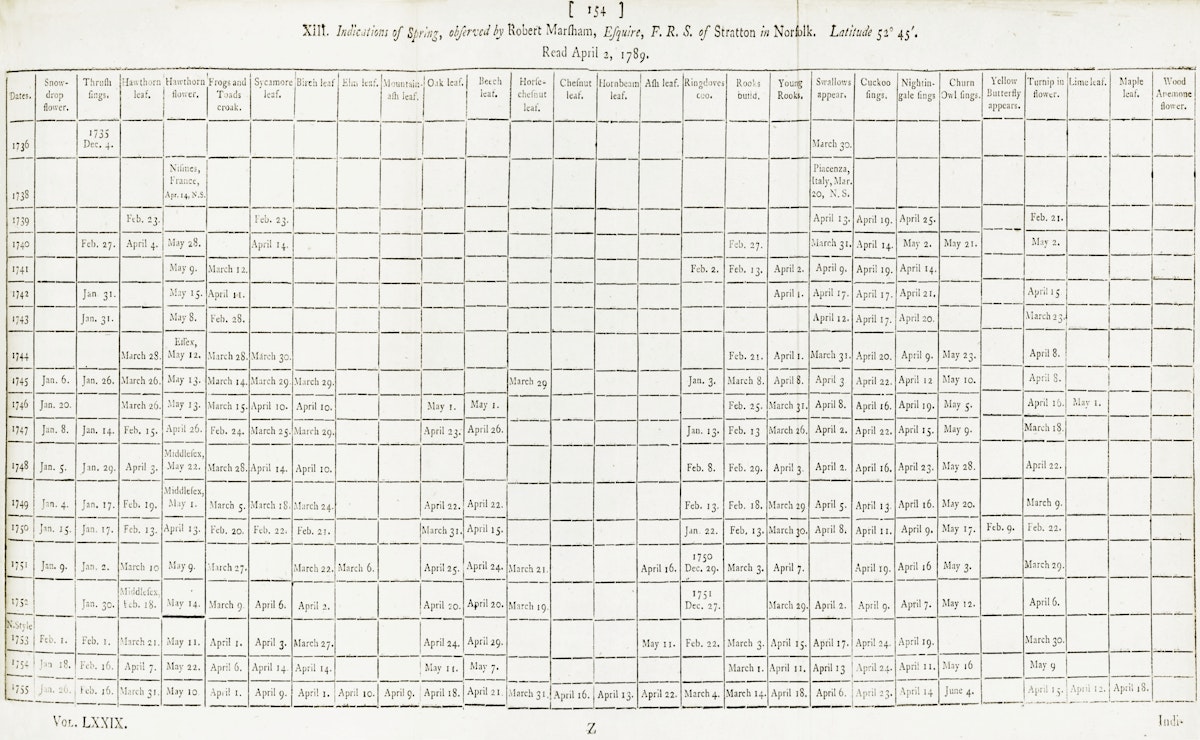 Scroll through the whole page to download all images before printing.
Scroll through the whole page to download all images before printing.Records spanning 1736–1755 from “Indications of spring, observed by Robert Marsham, Esquire, F. R. S. of Stratton in Norfolk. Latitude 52° 45'”, originally published in Philosophical Transactions 79 (1789) — Source.
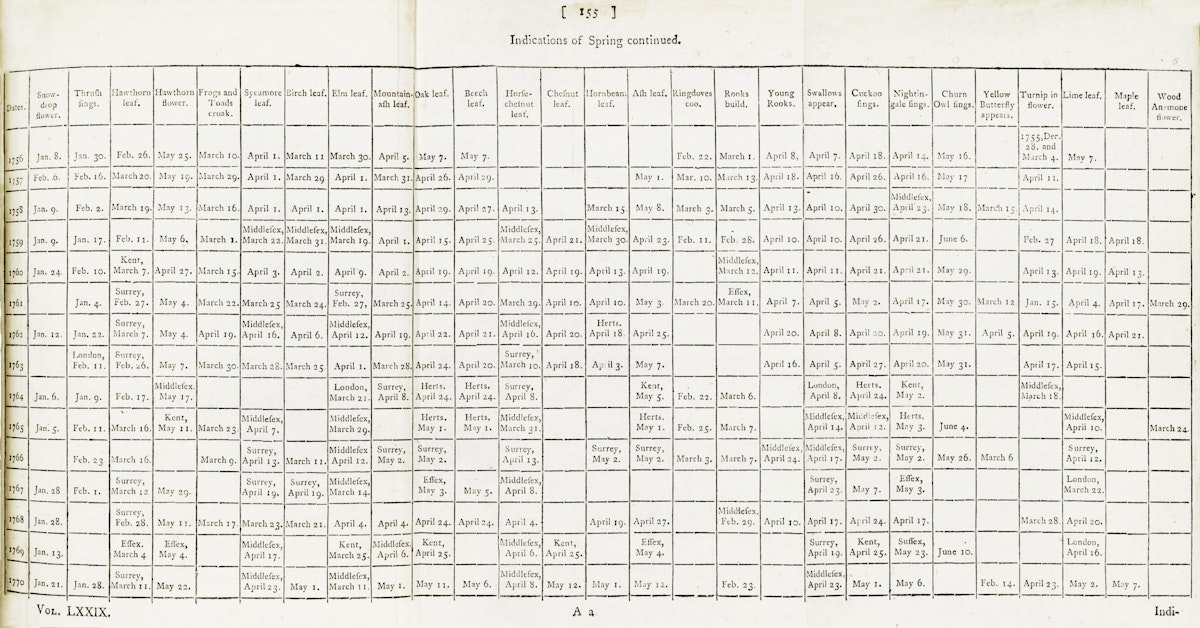 Scroll through the whole page to download all images before printing.
Scroll through the whole page to download all images before printing.Records spanning 1756–1770 from “Indications of spring, observed by Robert Marsham, Esquire, F. R. S. of Stratton in Norfolk. Latitude 52° 45'”, originally published in Philosophical Transactions 79 (1789) — Source.
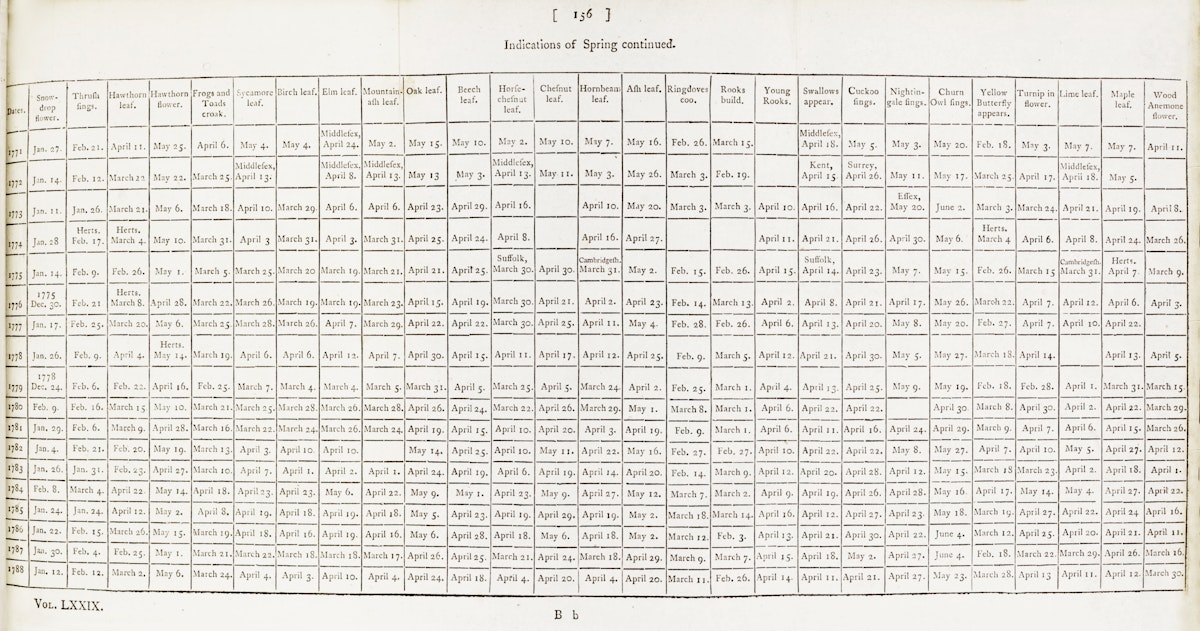 Scroll through the whole page to download all images before printing.
Scroll through the whole page to download all images before printing.Records spanning 1771–1788 from “Indications of spring, observed by Robert Marsham, Esquire, F. R. S. of Stratton in Norfolk. Latitude 52° 45'”, originally published in Philosophical Transactions 79 (1789) — Source.
The table shows how the project developed in Marsham’s mind. In the left-hand column, he dates all his observations by year, from 1736 to 1788. He begins tentatively with only a few obvious items, such as when he first hears the song thrush and the arrival of the first swallow, entering the date in the appropriate box in the table. Sometimes, he notes when an observation was made in another county, presumably while he was travelling. It is a few years before he settles into his methodology, developing a full list of twenty-seven items of flora and fauna recorded at home entirely on his own estate, selected so as to cover the whole spring season from winter to early summer. They include the leafing and flowering of hawthorn and the leafing dates of ash, oak, elm, beech, birch, hornbeam, and chestnut trees, as well as the dates on which birds such as the cuckoo and nightingale began to sing. The snowdrop flower is among the earliest things he expects to see. The last anticipated observation of the season is the distinctive calling of the nightjar, which he terms the “Churn Owl”, and which is still easily heard on warm evenings in the area today. Marsham continued to record this information until his death at the age of eighty-nine.
23 January 2024: I hear (but in the ivy cannot see) rival song thrushes trying out a few riffs for the mating season.
Born in 1708, Marsham inherited his father’s heathland estate north of Norwich in 1751. The sandy soil was too poor for growing crops or even grass for grazing — hence the local name Strawless. Instead, Marsham planted trees — tens of thousands, maybe even millions, of mainly deciduous species, chosen for their longevity over fast-growing pines — and in doing so transformed the landscape.
Marsham’s way with trees influenced the famous landscape gardener Humphry Repton, and they became friends in their old age. After Marsham’s death in 1797, Repton hoped to publish his notes on tree planting as a book, but the idea never came to fruition. Repton wrote that Marsham had achieved a “far better method of planting waste land, where enclosures are not permitted”.3 He was referring to Marsham’s choice of predominantly deciduous planting as well as his method of grouping and rooting the saplings. Repton followed this example in his artfully designed landscapes for many grand English country houses.
“I plant whenever I have leisure”, Marsham wrote.4 Only a few of his trees may still be discovered today. A giant twisted sycamore, which stands across the road from Stratton Strawless Hall, bears a sign attesting to its protected status as of 1995, but it is guarded by its own rotting fallen boughs and surely hasn’t long to live. A cedar planted in 1747 has grown to more than thirty metres. You can’t get close enough to hug its eight-metre girth as it lies within the bounds of a farm heavily armoured with hostile signage. It can best be seen from afar in any case, standing protectively head and shoulders above the surrounding mature woodland.
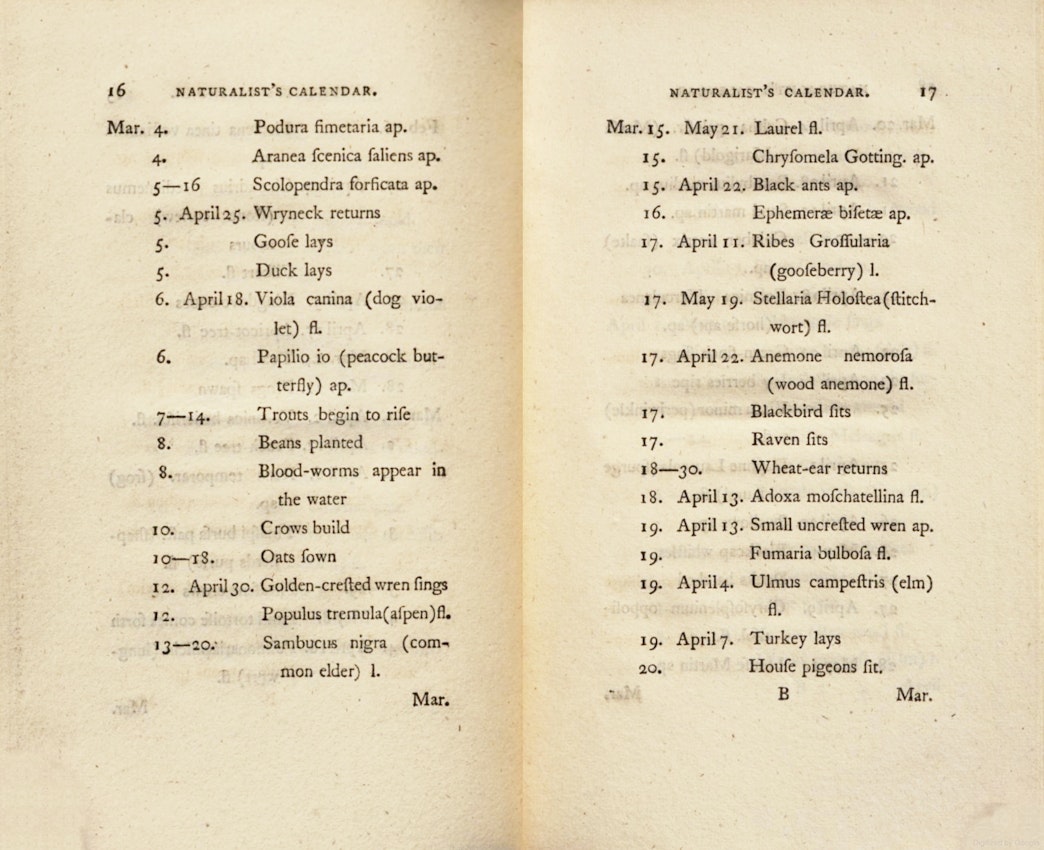 Scroll through the whole page to download all images before printing.
Scroll through the whole page to download all images before printing.Pages from Gilbert White, A Naturalist’s Calendar (1795), recording the dates of seasonal indications, mainly from 1768, which White notes was “rather a backward year”. The abbreviations denote flowering (fl.), first appearance (ap.), and leafing (l.) — Source.
Marsham also corresponded with Gilbert White, the most noted British naturalist in this period, who recorded the arrival dates of migratory birds to his Hampshire estate at Selborne. White praised Marsham as “a painful [i.e. painstaking] and accurate naturalist”.5 White’s The Natural History and Antiquities of Selborne (1789) was published in the same year as Marsham’s “Indications of Spring”, and thereafter the two men struck up a correspondence, although they never met. They compared notes on the sizes of the trees they had each planted in boyhood some seventy years earlier. One oak of Marsham’s had attained a girth of twelve and a half feet since he planted it at the age of twelve. “Perhaps you never heard of a larger Oak & the planter living”, he bragged.6 They also swapped notes about migration at a time when many people believed that birds simply hibernated during the winter rather than making long journeys. In October 1792, Marsham wrote to White with a truly remarkable find: “My man has just now shot me a bird which was flying about my house: I am confident I have never seen its likeness before.”7 The bird proved to be a wallcreeper — and the first recorded sighting of the species in the British Isles.
Marsham’s almost exact contemporary, the Swedish pioneer of biological taxonomy, Carl Linnaeus, also recorded the dates when trees flowered and fruited, but did not start until 1750 when he finally settled down after many travels and became the rector of Uppsala University. There are many who have made similar observations ever since. For example, the American writer Henry David Thoreau recorded the dates on which many of his plants first flowered for nearly a decade in the nineteenth century.
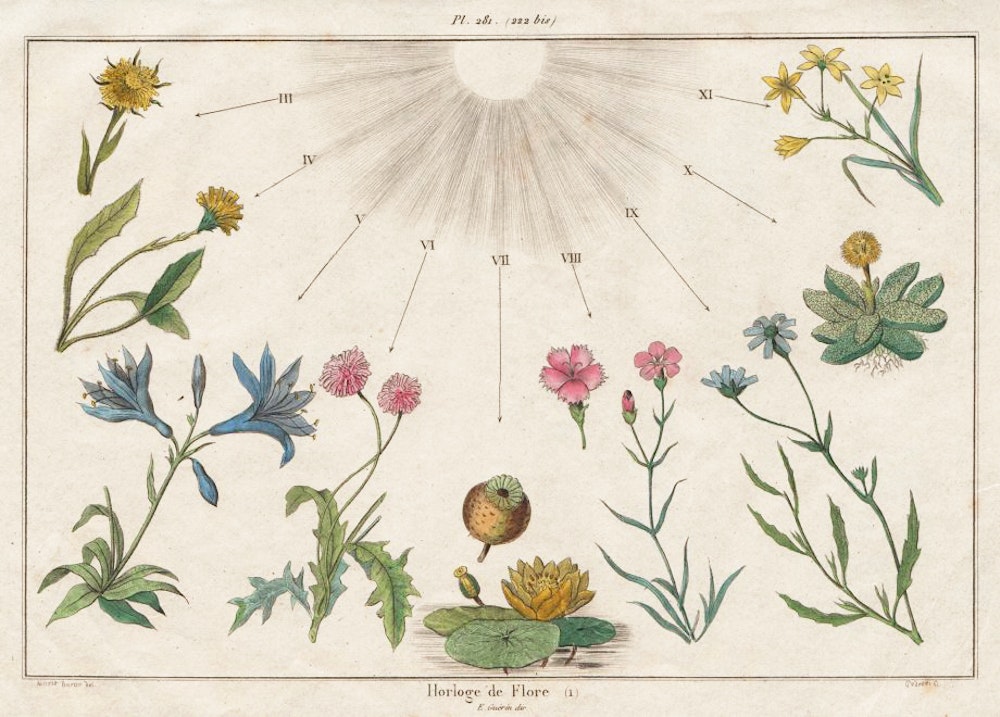 Scroll through the whole page to download all images before printing.
Scroll through the whole page to download all images before printing.1833 print depicting Carl Linnaeus’ “flower clock”, a horological device that tracks the day’s hours based on the circadian rhythms of flowers that exhibit “nastic” movement — the “opening” and “closing” of petals and leaves in response to light — Source.
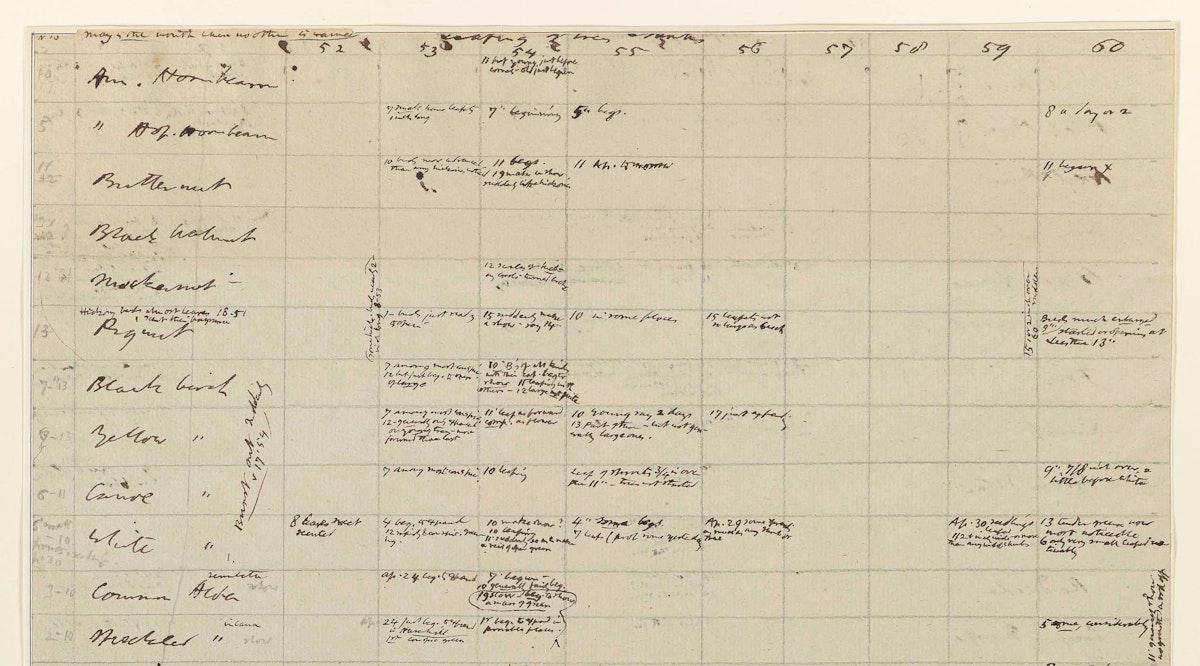 Scroll through the whole page to download all images before printing.
Scroll through the whole page to download all images before printing.Detail of a chart kept by Henry David Thoreau tracking the dates of first flowering for various plant species, such as “black birch” and “black walnut”, between 1852 and 1860 — Source.
Noticing signs of spring is not confined to the scientifically minded, of course. It is an idea with a long provenance. Buddhist monks in Japan were recording the arrival of the cherry blossom as far back as the ninth century. Some of Marsham’s “data points” (such as the swallow and the cuckoo) have long held a place in popular lore and folk songs. The old English saying “Ne’er cast a clout till May be out” — a warning not to remove outer clothes too soon in the year — is usually supposed to refer to the month of May. But English May weather is highly variable, and it is more likely that the saying refers to the May tree, or hawthorn, which generally flowers at some point during that month (long after it has come into leaf). Whether it does so early or late is determined chiefly by the weather conditions, making it a more reliable index for an appropriate choice of dress than a calendar date.
Robert Marsham’s project was handed down in the family and only came to a halt in 1958 when his great-great-great-granddaughter Mary died and her descendants were advised that their amateur contribution was no longer required, presumably judged to be no match for modern scientific methods. Despite its abrupt termination, it is the unbroken long run — 222 years — of Marsham’s “Indications of Spring” that gives it lasting scientific worth. There are a few patchy early records for places in the UK, but Marsham’s is the first truly systematic dataset, according to Tim Sparks, a professor of zoology and quantitative biology at the universities of Cambridge, Liverpool, and Poznań. “It is the longest such record for the UK and has been of immense value in determining the variability in spring and in its response to prevailing weather conditions. He inspired many others to do likewise.”8 Marsham’s record stretches back far enough that it can serve as a baseline for the investigation of changes that have already happened in the more recent past as well as for ongoing studies of the present situation.
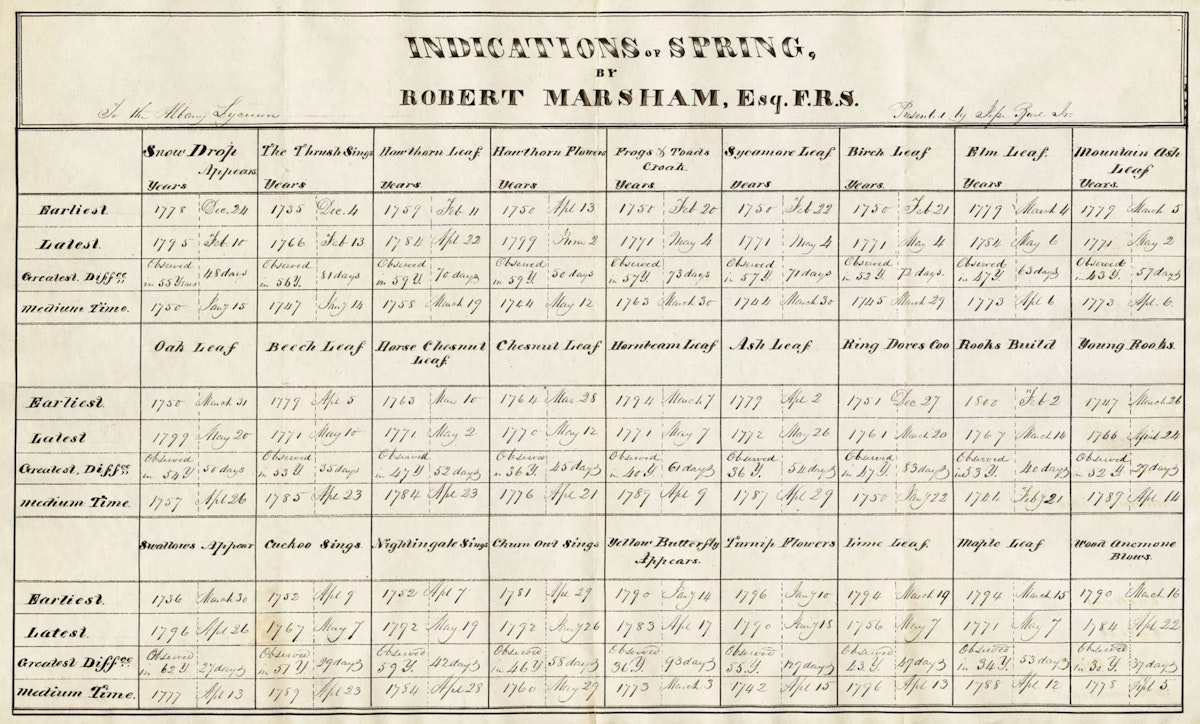 Scroll through the whole page to download all images before printing.
Scroll through the whole page to download all images before printing.Later rendering of Robert Marsham’s “Indications of Spring”, which was presented to the Albany Lyceum by Jesse Buel, Jr., an agricultural reformer, ca. 1800. The chart extrapolates lessons from Marsham’s data in a compressed form, and perhaps speaks to the phenologist’s legacy and reach — Source.
One merit of Marsham’s idea is surely that it is so easily grasped. You do not need to be a scientist to understand his results — or to begin recording your own data. In the mid-nineteenth century, the observation of seasonal changes in nature acquired its own name — phenology — as the gentleman scientists of the Victorian age began to add their contributions. Today, Marsham’s pioneering work inspires successor projects around the world, many of them examples of “citizen science”, relying on the participation of members of the public.
The UK Phenology Network, set up by the Woodland Trust and the Centre for Ecology and Hydrology, has more than 20,000 participating amateur recorders. The Royal Botanic Gardens at Kew organized the Great Plant Hunt, a citizen science project in which schoolchildren in Britain were encouraged to record their observations of buds, flowers, and leaves of different plants over one week in May. Extended nationwide, the project forms a snapshot illustrating the progress of spring in different regions — spring advances northward at about 2 mph (walking pace), as Marsham and White had found when they compared dates of their specific observations. These were usually found to be a couple of days apart, reflecting the fact that Stratton Strawless lies about 100 miles north of Selborne.
Data can be adduced indirectly as well. For example, Professor Sparks has found that the dates of flower festivals are being moved forward in the year, a sure sign of earlier blooms. In other circumstances, photographs taken annually at significant occasions that fall on a particular day can be used to reveal their own accidental record of the shifting seasons.
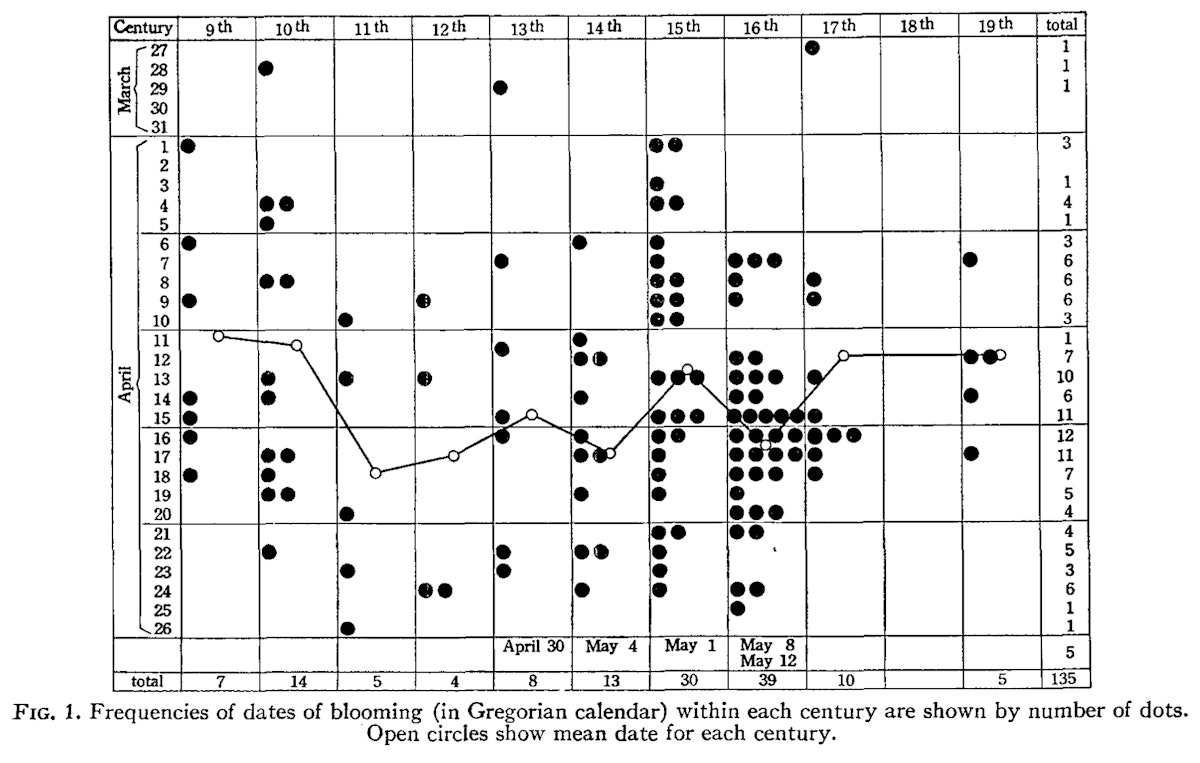 Scroll through the whole page to download all images before printing.
Scroll through the whole page to download all images before printing.Chart showing “frequencies of dates of blooming” for cherry blossoms in Kyoto by century, from a 1956 article by H. Arakawa in the Journal of Meteorology — Source (not public domain).
Phenology might fairly be described as one of the earliest sciences — crop yields are known to have been recorded 3,000 years ago. But it now has a magnified contemporary relevance because it provides not only an historic benchmark, in records such as Marsham’s, but also a continuing measure of climate change.
In the short run, phenological records reveal that natural occurrences are highly responsive to different seasonal conditions. The indications of spring are subject to more movement than we often imagine there to be, linked to weather factors such as frost, rainfall, and hours of sunshine. “It shows the variability in the timing of spring events”, says Professor Sparks. “These may typically be two to three months — much longer than human memory might falsely estimate.”9 Nor does everything happen in concert. Different indications of spring may be advanced or retarded by quite different amounts in the same place in any given year, even though environmental conditions are apparently the same. Comparison of phenological data with concurrently recorded temperatures reveals, for example, that beech trees come into leaf four days earlier for each 1°C rise in temperature, whereas birch will leaf ten days earlier.
Climate change is likely to exacerbate these effects. Research published in the journal Nature by the UK Centre for Ecology and Hydrology in 2016 indicates that seasonal events like those observed by Marsham are in general more sensitive to changes of temperature than to changes in other factors such as rainfall. Such disruptions have the potential to “desynchronise ecological interactions and thereby threaten ecosystem function”, according to Stephen Thackeray and his coauthors.10
This table of data is now almost all the evidence left of Marsham’s work with nature. At Stratton Strawless itself, much of his plantation was felled for timber during the world wars. In place of his rich deciduous woods, there are now fast-growing conifers. The house he knew was lost to fire a few years after his death, and its joyless nineteenth-century replacement now forms the office of a mobile home park. (Marsham always found new buildings a disappointment, as they began to decay from the moment of their completion, whereas a tree just grew in majesty.)
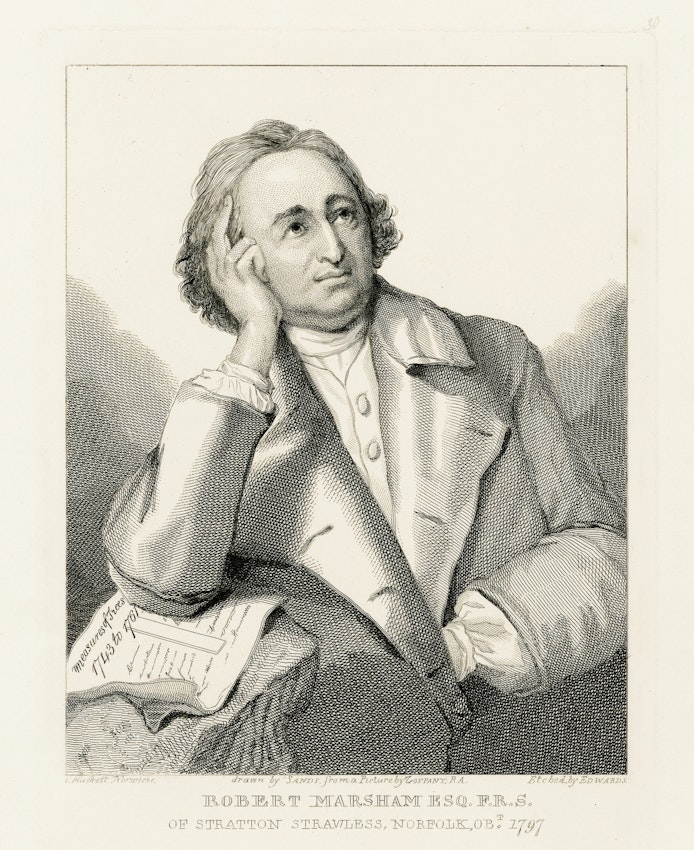 Scroll through the whole page to download all images before printing.
Scroll through the whole page to download all images before printing.Portrait engraving of Robert Marsham by William Camden Edwards, after a picture by Johan Joseph Zoffany, ca. 1797–1845. The headline of the newspaper under his elbow reads: “Measures of Trees / 1743 to 1761” — Source.
17 February 2024: During what is being reported as the warmest February on record, the hawthorn is beginning to come into leaf.
What do I learn from my effort to follow in Marsham’s footsteps? I find that not all my observations fall earlier than his of 250 years ago. My snowdrops appeared nearly four days later than Marsham’s averaged overall date, whereas my thrush sang eleven days earlier. My hawthorn leafing date fell more than three weeks earlier than Marsham’s average. This may say little more than that we experienced a cold snap in January followed by an unusually mild first half of February. But, given that February is heading toward breaking numerous heat records both nationally and globally, it would also seem evidential of climate change.
Perhaps Marsham found, as I am finding, that close observation changes your perception of the season. The detection of the very earliest signs, such as snowdrops, before any general warming is felt, holds out hope of renewal. Spotting one sign shortly after another exposes the endless longueur of winter as a sham, and is a reminder that time is in fact hurrying on. Spotting several signs in rapid succession is further proof that spring is gathering pace and a promise of the abundance of nature to come.
“The spring is coming by a many signs”, the poet John Clare wrote in the century after Marsham.11 I am submitting this article on February 20 in time for you to read it during the spring (if you live in the northern hemisphere). I have not yet seen the rowan or the beech or the birch come into leaf, I have not yet heard the frogs and toads begin to croak, I have not yet observed the first arriving swallow. But if you have the chance to get outside, you might catch them yet, and become part of Marsham’s great experiment.
Hugh Aldersey-Williams is a writer and curator. He is the author of Dutch Light: Christiaan Huygens and the Making of Science in Europe (Picador, 2020), as well as a cultural history of the chemical elements, Periodic Tales (Penguin, 2011), and The Adventures of Sir Thomas Browne in the 21st Century (Granta, 2015).





